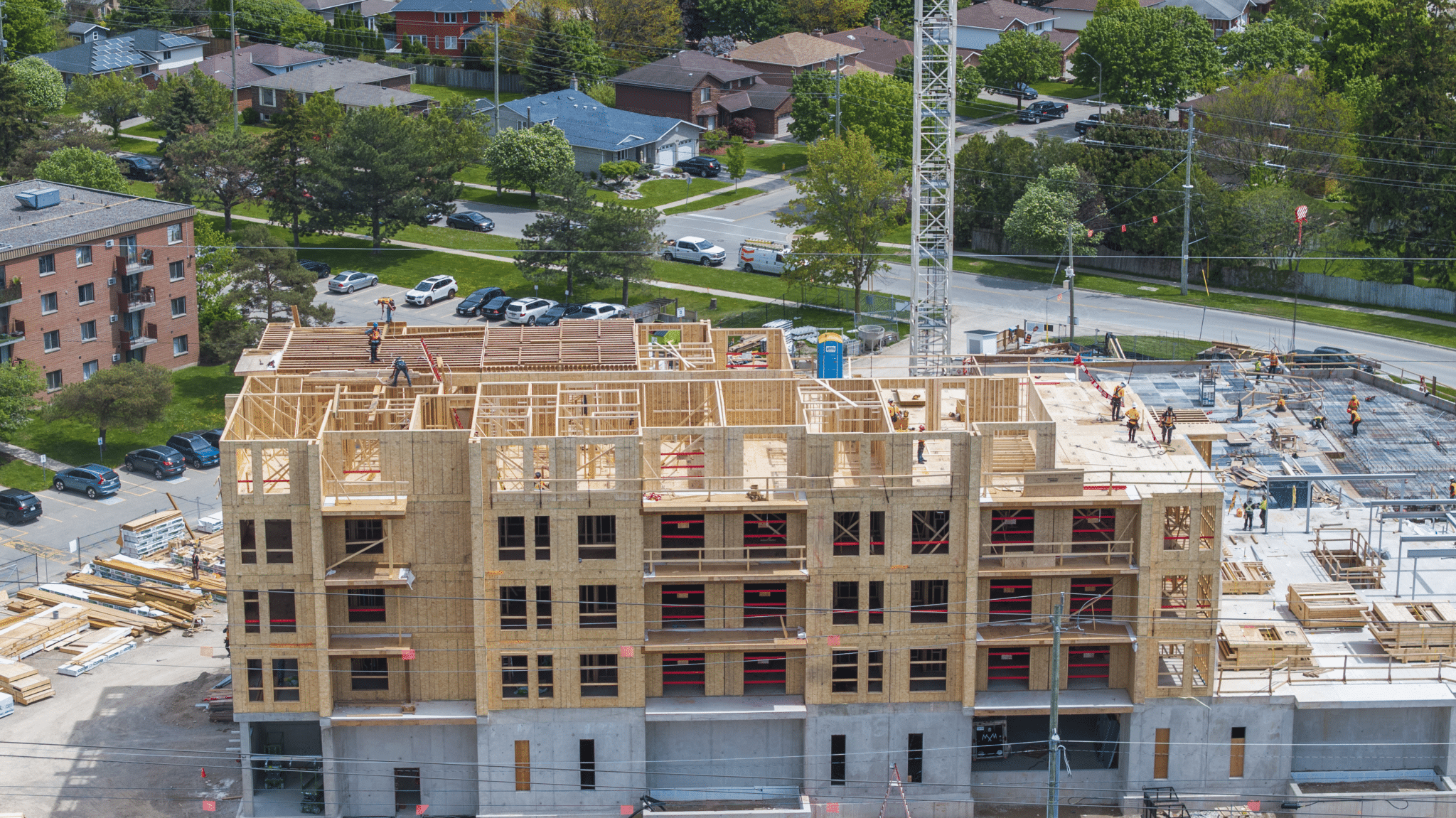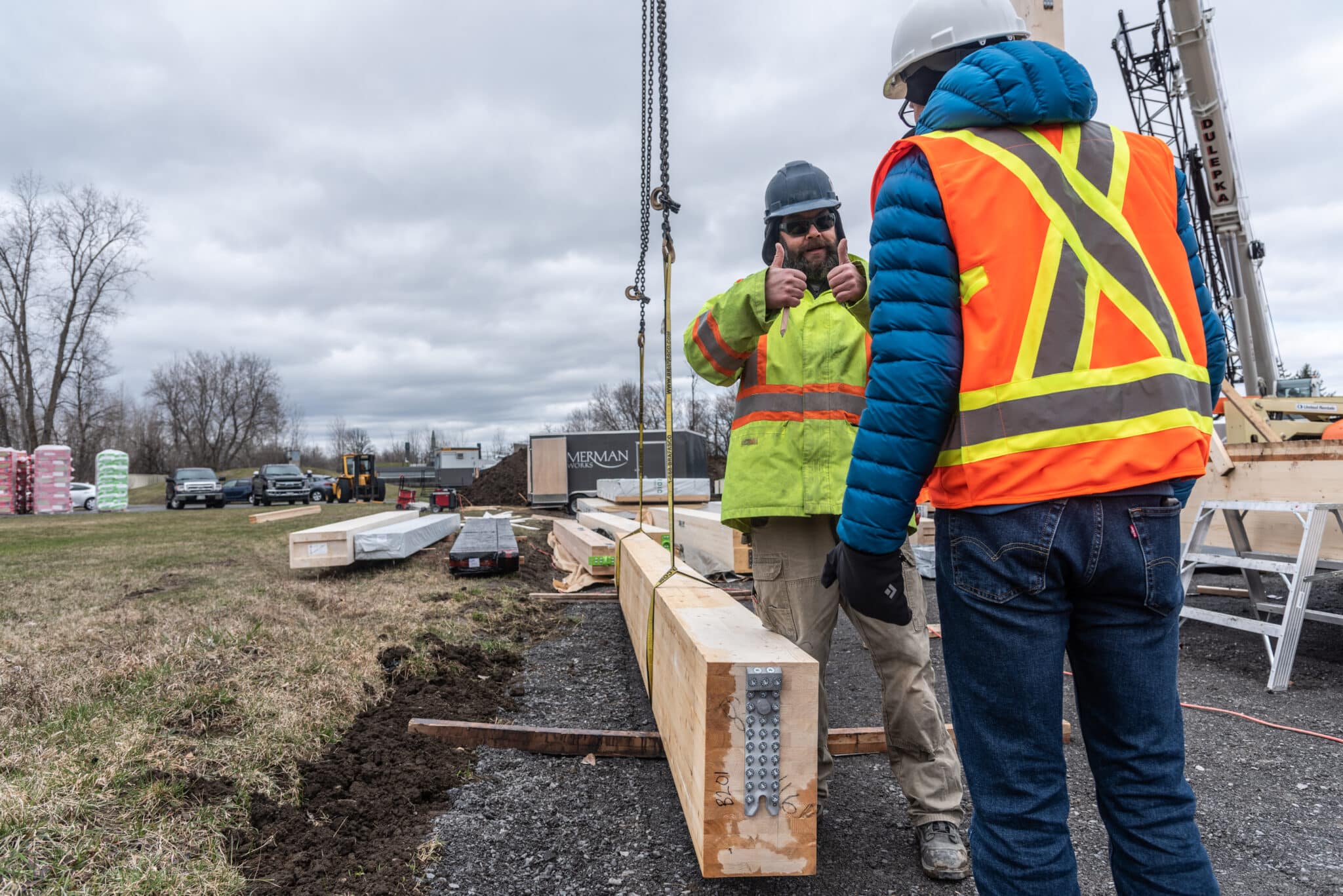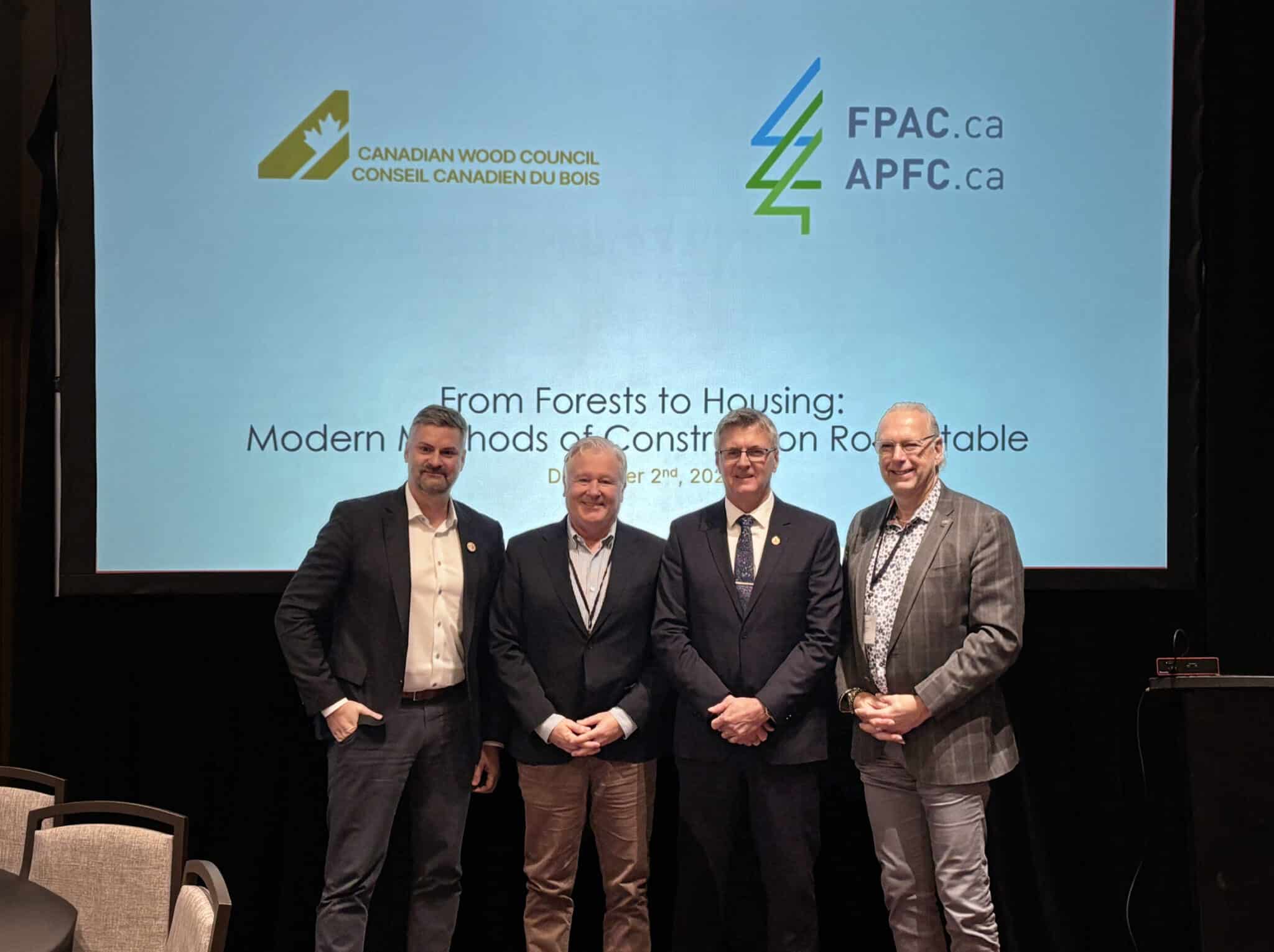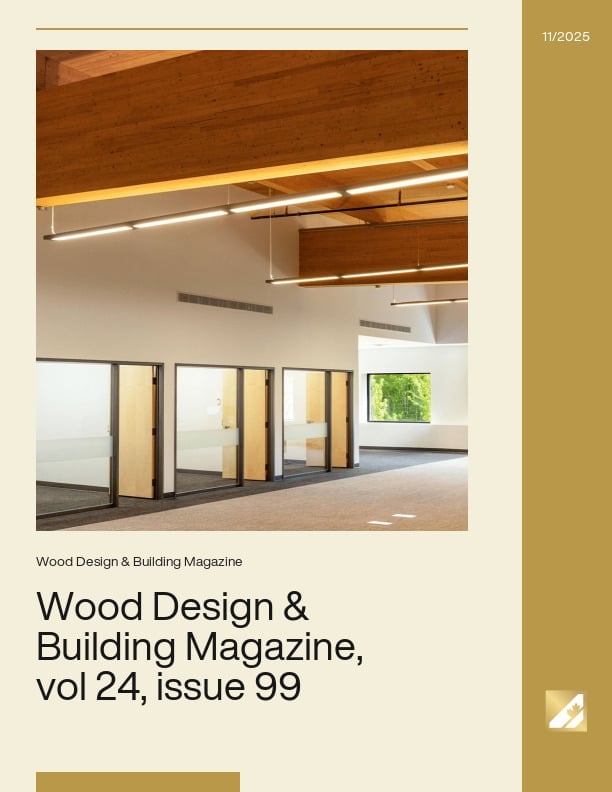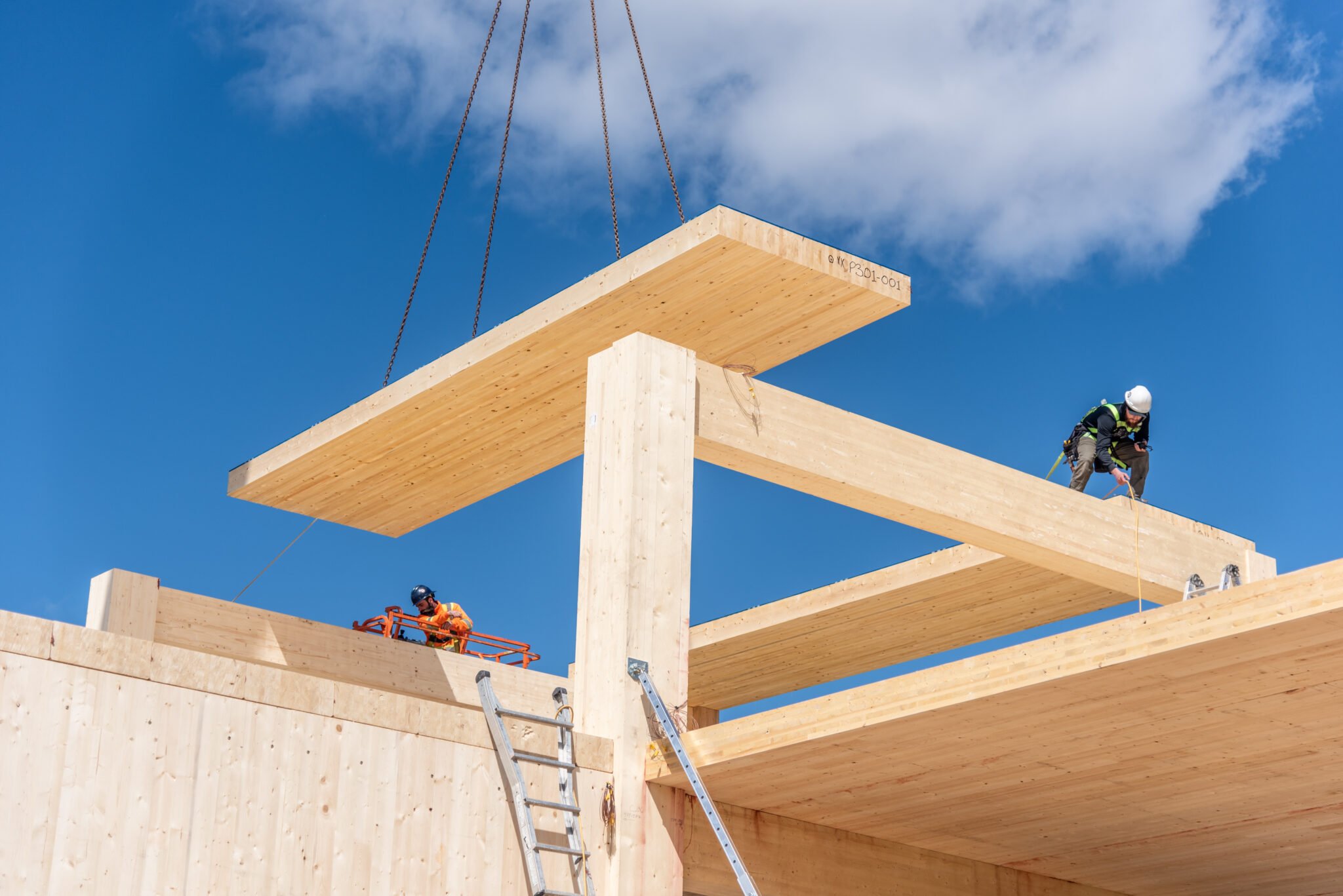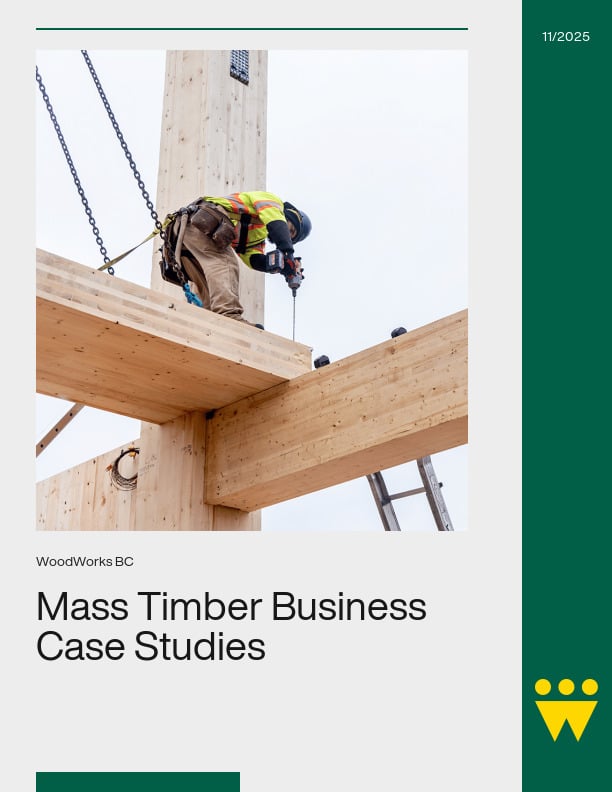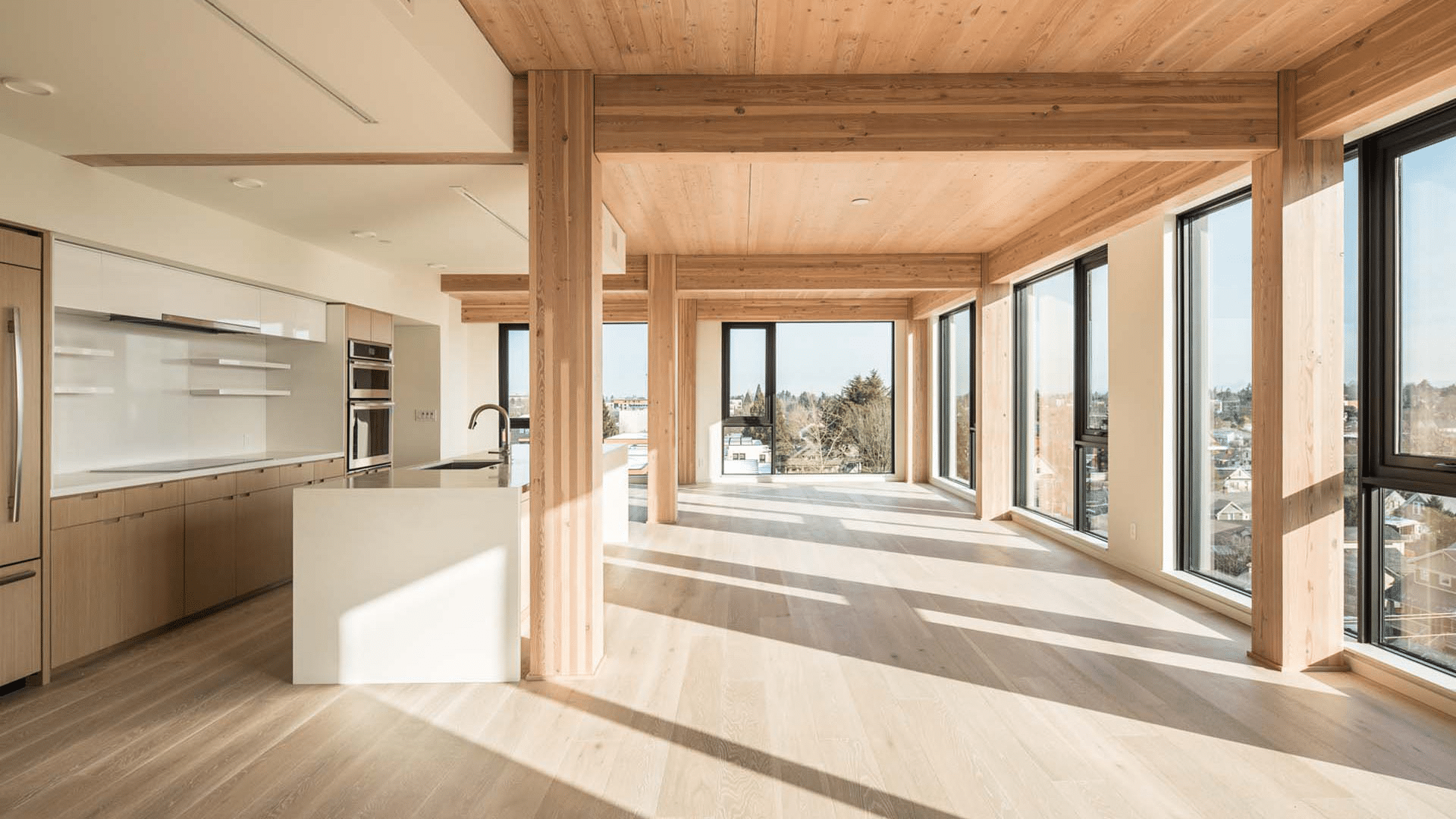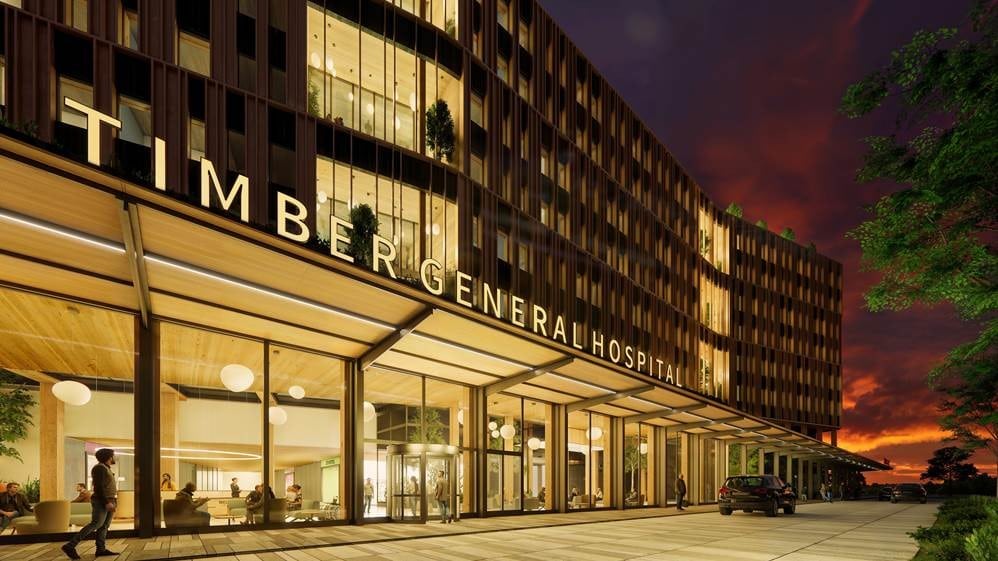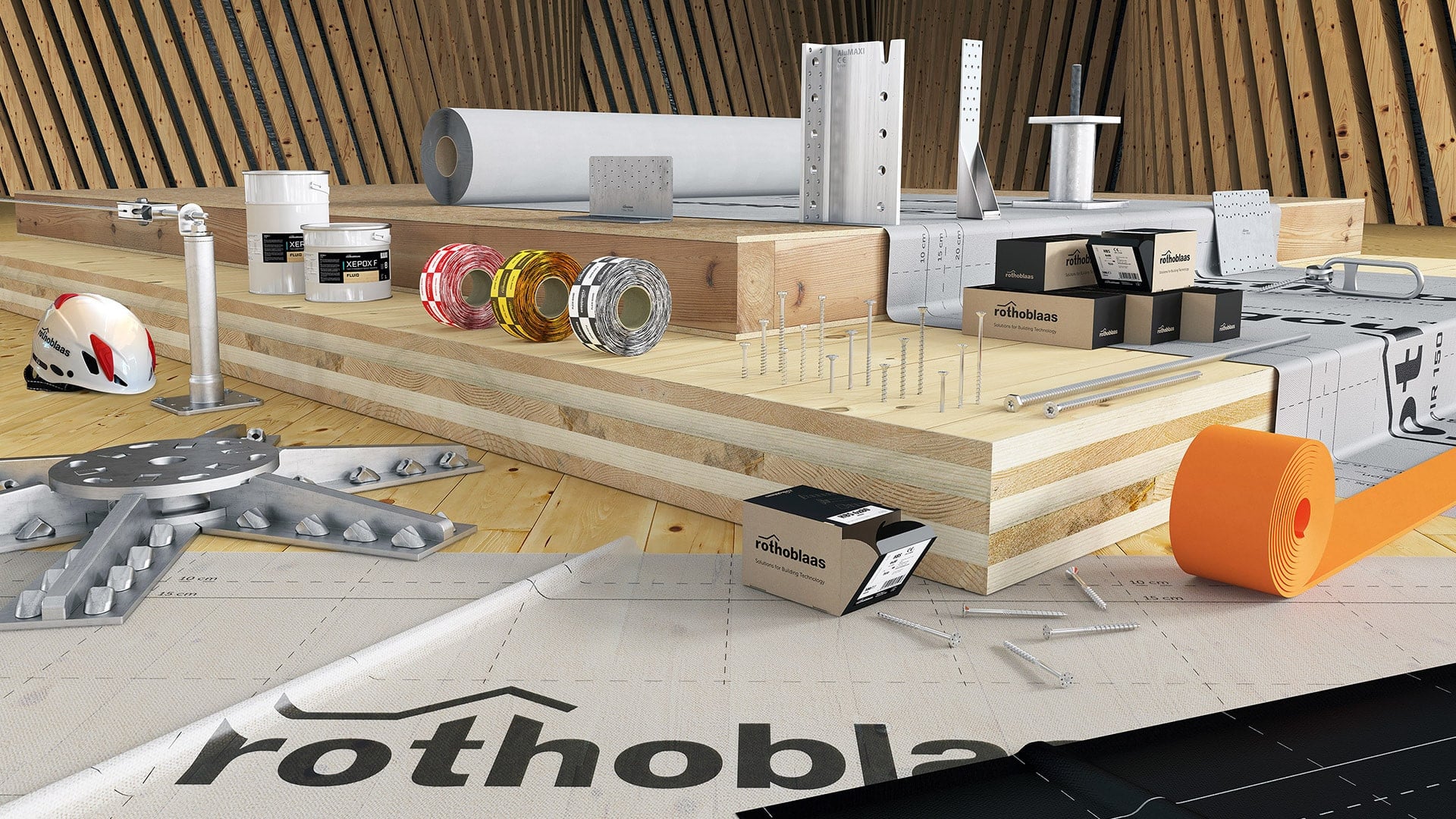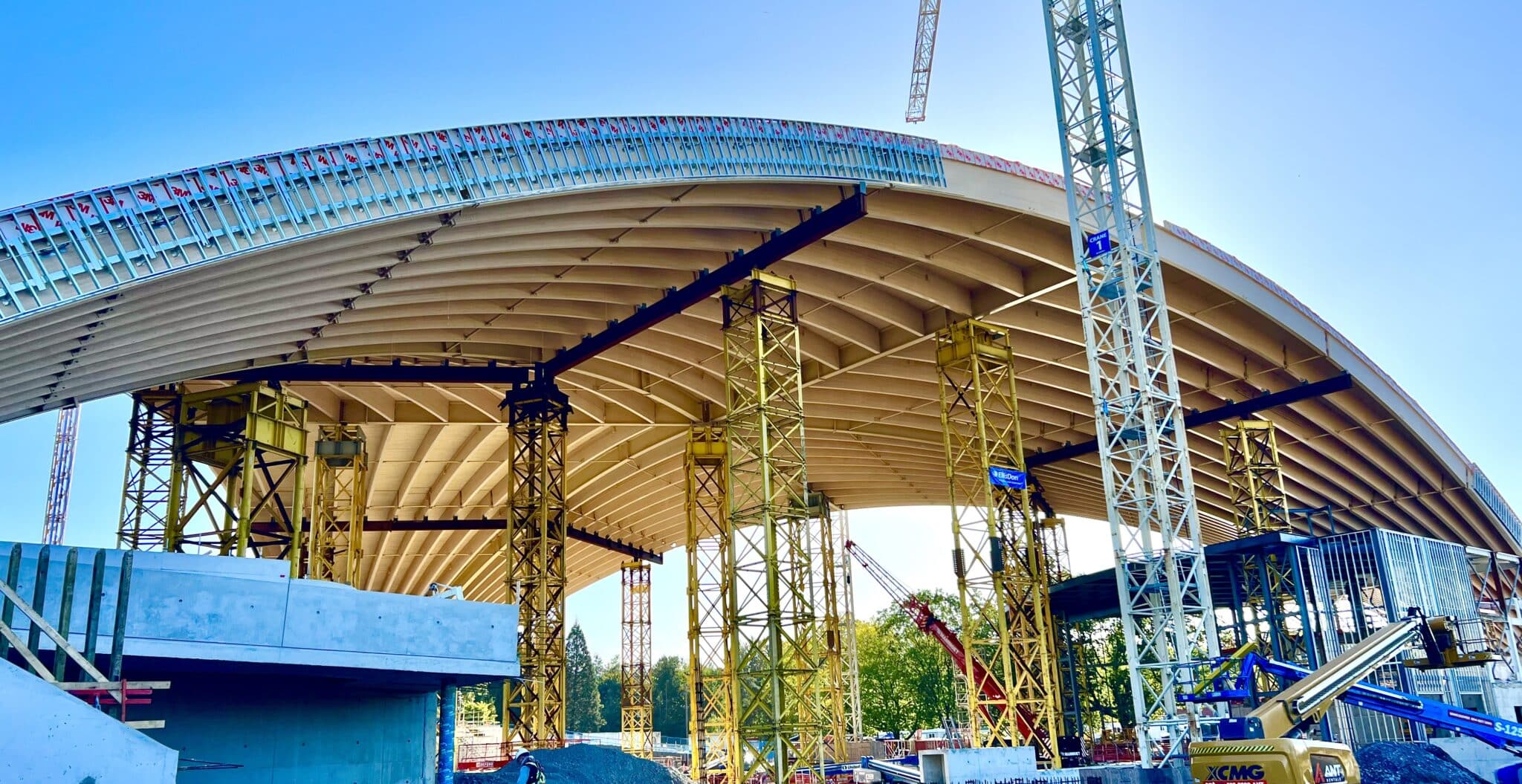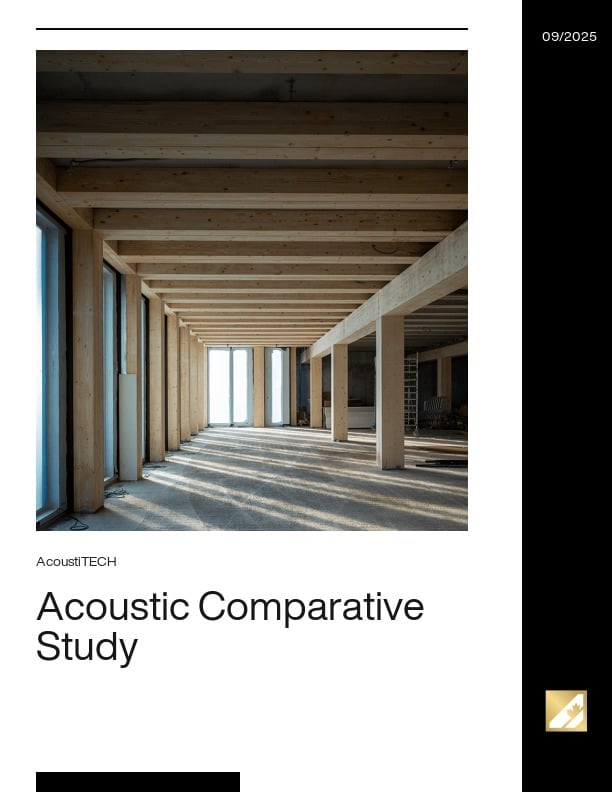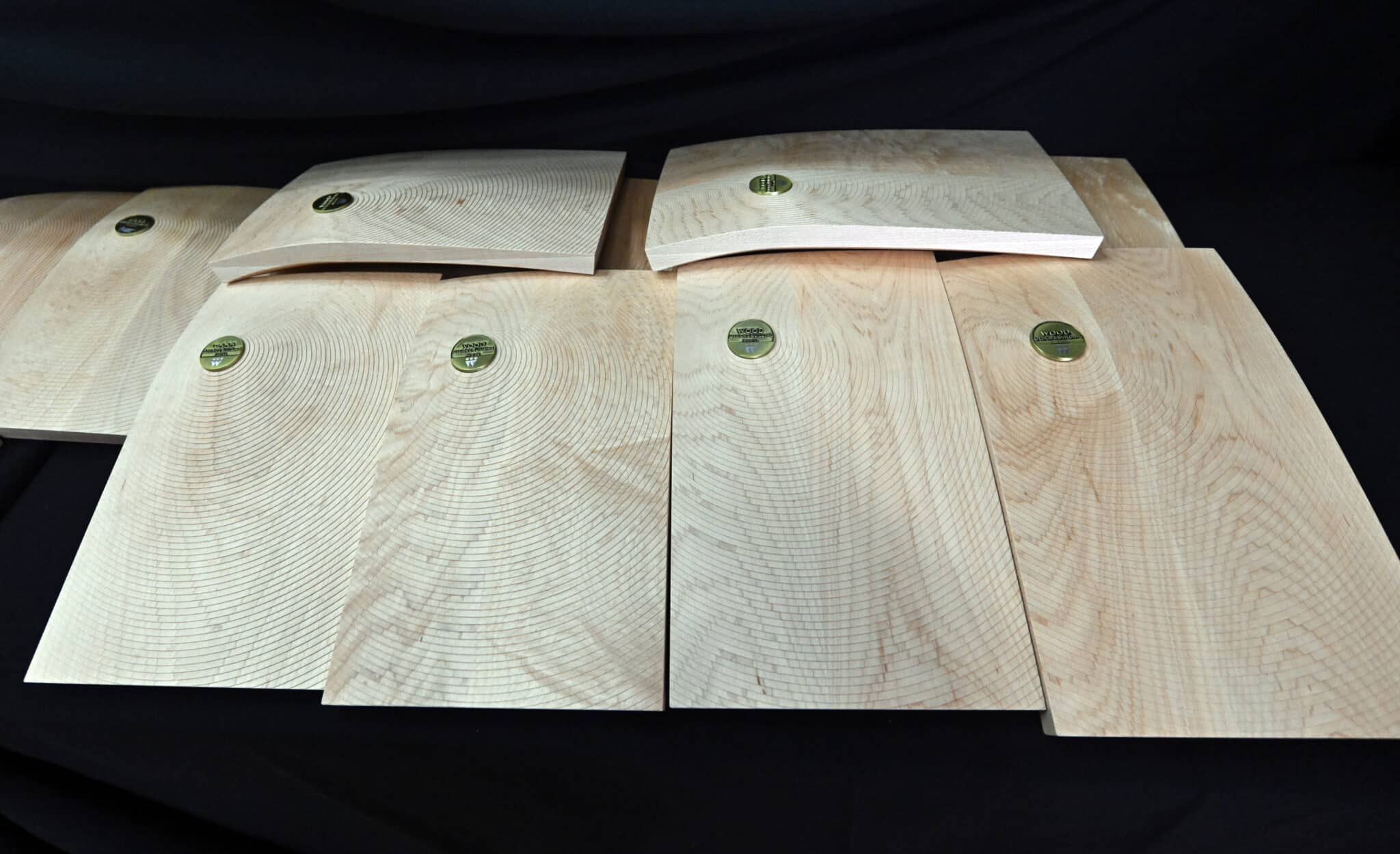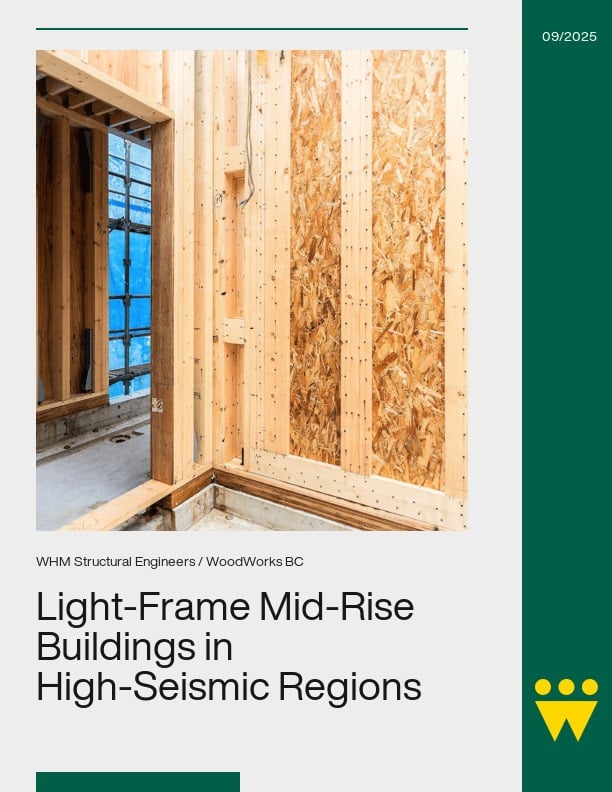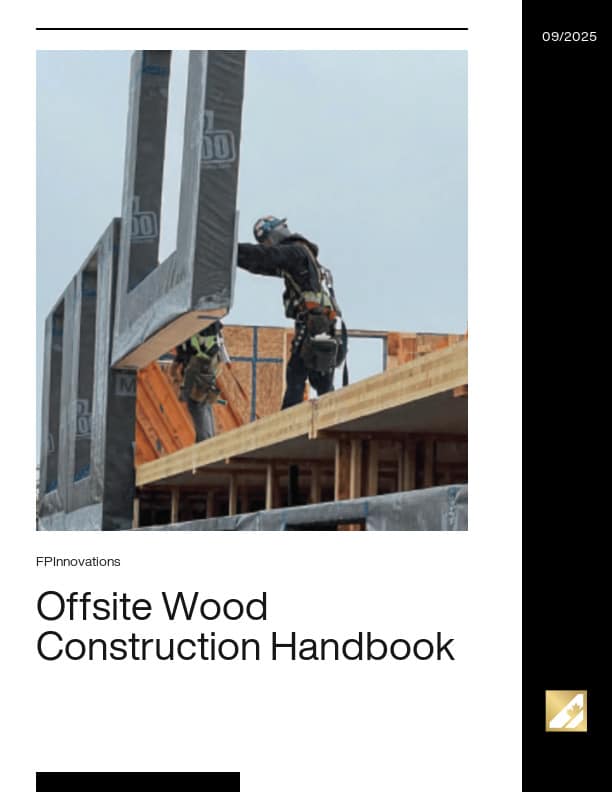Bienvenue sur le portail CCB
Outils et calculatrices pour la conception du bois
Le Conseil canadien du bois (CCB) offre des outils de conception simples, faciles à utiliser et gratuits pour aider les architectes, les ingénieurs et les constructeurs à travailler plus efficacement avec le bois. Qu'il s'agisse de calculateurs de conception électroniques ou de guides de construction pratiques, nos ressources rendent la conception en bois plus accessible et plus simple.
Le CWC propose un certain nombre de ressources gratuites destinées aux professionnels et aux amateurs du bois.

Calculateur de bois de masse exposé

Calculateur de contreventement éolien et sismique
Cet outil interactif a pour but d'aider à la conception de la longueur minimale des panneaux muraux contreventés requis pour les maisons en fonction des forces sismiques et éoliennes.
Des solutions d'assemblage de murs isolés adaptées aux zones climatiques et facilement comparables aux dispositions normatives nationales et provinciales en matière d'efficacité énergétique.
Calculer efficacement la capacité de charge des poutres en bois. Fournit des résultats rapides et conformes au code pour des conceptions sûres et fiables.
Calculateur de dimensions
Convertit facilement les dimensions du bois pour une planification précise. Idéal pour assurer des coupes précises et minimiser les pertes.
Estimez le volume de bois pour vos projets. Simplifiez la planification des matériaux et l'estimation des coûts grâce à des résultats précis.
Calculateur de carbone
La quantité de carbone stockée et la quantité d'émissions de gaz à effet de serre évitées.
Code CHEK
S'assurer que vos conceptions répondent aux normes de sécurité. Vérifier la conformité avec les derniers codes de construction pour des projets en toute sérénité.
Outil FRR & STC
Évaluer la résistance au feu et les performances acoustiques. Optimiser les conceptions pour répondre facilement aux normes de sécurité et d'acoustique.
Tableau de sélection des boulons
Évaluer la résistance au feu et les performances acoustiques. Optimiser les conceptions pour répondre facilement aux normes de sécurité et d'acoustique.
Calculateur de boulons
Effectue les calculs de conception des assemblages boulonnés conformément à la clause 12.4 de la norme CSA O86:24.
Les outils de conception du Conseil canadien du bois ont été développés à titre informatif uniquement. Bien que tous les efforts possibles aient été déployés pour garantir l'exactitude des informations contenues dans ces outils, le CWC ne peut en aucun cas garantir l'exhaustivité, l'exactitude ou l'exactitude des informations. Il faut toujours faire référence au code et/ou à la norme du bâtiment approprié. Cet outil ne doit pas être utilisé comme substitut à des conseils juridiques ou de conception, et l'utilisateur est responsable de la manière dont l'outil est utilisé ou appliqué.
Explorer des outils supplémentaires
Développez vos capacités de conception avec des outils avancés adaptés à la construction en bois. Des calculatrices à la modélisation des performances, ces ressources améliorent votre flux de travail pour une exécution de projet précise et efficace.
Outils en ligne Cecobois
Des solutions d'assemblage de murs isolés adaptées aux zones climatiques et facilement comparables aux dispositions normatives nationales et provinciales en matière d'efficacité énergétique.
Outils en ligne de l'AWC
Découvrez des outils innovants conçus pour rationaliser vos projets de construction en bois. Optimisez les processus de conception et explorez des solutions conçues pour l’ingénierie moderne du bois.
Découvrez le logiciel WoodWorks
Découvrez comment le logiciel WoodWorks aide les professionnels de la conception et de la construction grâce à des ressources spécialisées, des outils et une assistance technique gratuite pour des projets de construction en bois innovants.
Explorer la prime
Contenu et ressources
Des meilleures pratiques aux techniques innovantes, trouvez tout ce dont vous avez besoin pour réussir dans la construction en bois.
La variabilité de la conception des assemblages est souvent considérée comme un facteur de coût important pour les projets de construction en bois massif, mais les concepteurs manquent souvent d'indications claires sur ce que pourraient être des solutions standard. L'objectif de ce document est de fournir à l'industrie de la construction des pratiques de détail normalisées qui couvrent une large gamme d'assemblages couramment rencontrés dans les bâtiments en bois massif au Canada. Ces détails peuvent être adaptés à plusieurs projets avec différentes équipes de conception et différents fournisseurs. L'accent est mis sur la haute capacité, la simplicité d'installation et la rentabilité globale des assemblages en bois.
Six détails sont présentés, basés sur des connexions typiques de poutres, de colonnes et de murs. Ce document décrit également les domaines de conception qui ont été privilégiés lors de l'élaboration des détails. Enfin, une liste de contrôle est fournie aux dessinateurs pour s'assurer que toutes les priorités sont prises en compte. Les versions 3D de ces détails peuvent être téléchargées ici.
- La rapidité, le coût et la durabilité ne sont plus des " avantages " dans la construction multi-résidentielle - ils sont essentiels. Joignez-vous à WoodWorks en partenariat avec l'Association ontarienne du bois de charpente (OSWA) pour FRAMEWORK for Success : Les systèmes préfabriqués en bois et l'innovation en matière de conception, un webinaire de 60 minutes qui explore la façon dont les systèmes d'ossature légère en panneaux sont en train de remodeler la livraison de logements de taille moyenne. Cette session explore en profondeur la méthodologie FRAMEWORK de VanMar et son application dans le monde réel sur le projet 150 Wissler Road à Waterloo - démontrant comment la préfabrication hors site peut accélérer les délais, contrôler les coûts et atteindre des objectifs ambitieux en matière d'énergie et d'émissions de gaz à effet de serre. Résultats d'apprentissage : Les participants comprendront les avantages de la construction à ossature bois préfabriquée pour les bâtiments multi-résidentiels. Les participants comprendront l'approche du système FRAMEWORK en matière de rapidité, de rentabilité et de durabilité. Les participants verront comment les méthodes de construction collaborative hors site ont accéléré le projet du 150 Wissler Road. Les participants apprendront des stratégies pour surmonter les défis de la conception et réaliser des économies dans les murs coupe-feu, les puits et l'acoustique.
Ottawa, ON, 16 décembre 2025 - Le Conseil canadien du bois (CCB) est heureux d’annoncer les noms de la lauréate et des lauréats d’une Bourse commémorative Catherine Lalonde 2025. Il s’agit de Houman Ganjali, de l’Université du Nord de la Colombie-Britannique, de Kalkidan Tesfaye Shewandagn, de l’Université McGill et de Henri Monette, de l’Université de Toronto. Ces étudiants exceptionnels des cycles supérieurs ont été choisis pour l’excellence dont ils ont fait preuve sur le plan universitaire et pour la recherche de pointe qu’ils ont menée dans le but de stimuler l’innovation dans le domaine des produits structuraux et des systèmes de construction en bois.
Créées il y a 20 ans, ces bourses commémoratives honorent la mémoire de Catherine Lalonde, dont le leadership en tant qu’ingénieure et présidente du CCB a contribué à façonner la trajectoire de la conception et de la construction en bois au Canada. Chaque année, ces prix rendent hommage à des étudiantes et à des étudiants des cycles supérieurs, dont les travaux reflètent les normes d’excellence scientifique, les répercussions sur l’industrie et la passion que Catherine a incarnée tout au long de sa carrière pour ce matériau qu’est le bois.
Cette année, le Conseil canadien du bois a reçu 51 candidatures, un nombre record dans l’histoire du programme de bourses commémoratives Catherine Lalonde. Ces candidatures, qui reflètent un haut niveau de rigueur universitaire et une solide orientation vers les défis de l’industrie, témoignent de la vitalité de la communauté scientifique et de l’intérêt croissant pour la construction en bois. Elles attestent aussi l’importance de stimuler l’utilisation du bois dans l’environnement bâti.

Houman Ganjali
Houman est doctorant de cinquième année en génie à l’Université du Nord de la Colombie-Britannique. Ses recherches portent sur les performances structurales des planchers en bois lamellé-croisé (CLT) avec appuis ponctuels, plus particulièrement sur la résistance au cisaillement par roulement des panneaux en CLT et sur la capacité de poinçonnement des systèmes à appuis ponctuels. Ses travaux explorent également les stratégies de raccordement le long de l’axe de résistance secondaire des panneaux CLT, les méthodes de renforcement des appuis ponctuels ainsi que le comportement des planchers à appuis ponctuels par rapport au fluage et aux vibrations. Les travaux de Houman ont abouti à l’élaboration d’une proposition de méthode de calcul relative à la résistance des planchers en CLT à appuis ponctuels. Cette proposition sera présentée au comité technique CSA O86 en vue d’une éventuelle inclusion dans les prochaines éditions de la norme.

Kalkidan Tesfaye Shewandagn
Kalkidan est doctorante de deuxième année en génie civil à l’Université McGill. Ses recherches portent sur le dimensionnement structural sous charge sismique et sur l’évaluation de la performance des bâtiments à ossature bois construits sur podium. En intégrant des essais expérimentaux, une modélisation non linéaire (OpenSeesPy) et une évaluation axée sur les performances, ses travaux quantifient l’interaction entre les systèmes à ossature en bois et les podiums. Les lignes directrices qui en découlent visent à élargir l’adoption du bois dans les bâtiments à plusieurs étages et les structures hybrides partout au Canada.

Henri Monette
Henri est doctorant en quatrième année au programme de génie civil et minier de l’Université de Toronto. Ses recherches se penchent sur la mise au point d’un connecteur à forte résistance pour les structures en bois massif – un système novateur conçu pour optimiser l’utilisation des fibres du bois en mobilisant la pleine résistance sectionnelle des panneaux de bois connectés. En s’employant à repousser les limites de résistance et de résilience des technologies de raccordement actuelles, les travaux d’Henri soutiennent la capacité du bois massif à concurrencer et à remplacer les matériaux traditionnels comme l’acier et le béton.
« Le nombre impressionnant de candidatures que nous avons reçues cette année témoigne de la formidable vitalité de la recherche axée sur le bois, partout au Canada », a déclaré Blériot Feujofack, gestionnaire de l’éducation au bois au Conseil canadien du bois. « Les lauréats de cette année illustrent brillamment l’excellence universitaire observée dans l’ensemble du bassin de candidats, lesquels se distinguent par la rigueur méthodologique et la pertinence pratique de leurs travaux. Leurs résultats apportent un éclairage précieux pour les praticiens, les développeurs de codes et les partenaires de l’industrie. Ils contribueront à l’avancement continu de la construction en bois au Canada. »
À propos du Conseil canadien du bois
Le Conseil canadien du bois (CCB) est la voix unifiée de l’industrie canadienne des produits du bois. Regroupés au sein d’une fédération nationale d’associations, ses membres représentent des centaines de fabricants de partout au pays. Le CCB soutient ses membres en contribuant à accroître la demande pour les produits du bois et en faisant la promotion d’un leadership responsable, guidé par les plus hauts standards en matière de codes, de normes et de règlements. Le CCB offre également une assistance technique et un transfert de connaissances au secteur de la construction par l’intermédiaire de son programme WoodWorks, une référence sur le marché.
Toronto, ON - 15 décembre 2025 - Le Conseil canadien du bois (CCB) salue l'annonce faite aujourd'hui par l'honorable Tim Hodgson, ministre de l'Énergie et des Ressources naturelles, à l'Office de protection de la nature de Toronto et de la région. L'événement célébrait le financement de projets qui renforcent le secteur forestier canadien et favorisent l'innovation dans les solutions à base de bois.
Le CWC a reçu 8,5 millions de dollars depuis 2023 pour développer l'utilisation des produits à base de bois, élargir l'éducation sur la construction en bois et contribuer à l'avancement du Code national du bâtiment.
Le Conseil canadien du bois apprécie grandement le leadership continu du gouvernement du Canada dans la promotion de la construction innovante et à faibles émissions de carbone grâce au programme GCWood. Ce financement a permis au CWC et à son programme WoodWorks de soutenir les professionnels de la conception et de la construction en leur fournissant des ressources spécialisées, des outils et des conseils qui contribuent à accélérer l'adoption de la construction en bois à l'échelle nationale. En poursuivant ce travail, nous contribuerons à stimuler une demande durable pour des solutions de construction qui sont non seulement innovantes, mais aussi reproductibles et rapidement déployables, des approches qui aideront à relever les défis du Canada en matière de logement et d'accessibilité financière à grande échelle.
Le CWC et WoodWorks fournissent :
- assistance technique dans le cadre de projets destinés aux architectes, ingénieurs, promoteurs et constructeurs dans le domaine de la conception et de la construction en bois ;
- éducation et formation par le biais de programmes spécialisés, de conférences, de webinaires et de ressources développés pour les étudiants de l'enseignement supérieur, les artisans et les professionnels de la construction afin de soutenir les technologies avancées de construction en bois, notamment le bois massif et les produits en bois d'ingénierie ;
- opportunités de développement d'un réseau d'experts permettant aux professionnels du secteur de se rencontrer et de partager les meilleures pratiques ; et
- participation du secteur à l'élaboration de codes nationaux afin de faciliter une meilleure compréhension et l'adoption de techniques avancées de construction en bois basées sur la performance.
« Le soutien de GCWood nous permet de fournir des services de conseil technique essentiels, d'offrir une formation axée sur le bois aux professionnels actuels et futurs, et de contribuer à l'élaboration de codes qui reflètent les atouts en constante évolution des produits et des systèmes modernes en bois. Les investissements de GCWood sont des apports stratégiques importants qui renforcent les secteurs de la foresterie, de la fabrication et de la construction au Canada. Nous sommes impatients de poursuivre notre travail en collaboration avec des partenaires de tout le pays afin d'accélérer l'adoption de solutions durables en bois et de méthodes de construction modernes. » – Rick Jeffrey, président et directeur général, Conseil canadien du bois.
Le Conseil canadien du bois se réjouit à l'idée de collaborer avec ses partenaires et les parties prenantes à mesure que ces projets avancent, afin de soutenir le leadership du Canada dans les domaines de la construction durable et de la foresterie.
Contexte
- Le Conseil canadien du bois a reçu 4 999 536 $ pour accroître l'utilisation de solutions, de systèmes et de produits à base de bois au Canada en renforçant les compétences dans l'utilisation du bois comme matériau de construction grâce à un soutien technique direct, à la formation, à la sensibilisation et au réseautage.
- Le Conseil canadien du bois a reçu 2 942 610 $ pour un deuxième projet visant à augmenter le nombre d'offres et de contenus éducatifs liés à la construction en bois afin d'améliorer la compréhension et l'acceptation du bois comme matériau de construction par les étudiants de niveau postsecondaire, les artisans et les autres professionnels de l'industrie de la construction.
- Le Conseil canadien du bois a reçu 594 000 dollars pour un troisième projet visant à permettre à l'industrie forestière de participer, au cours des trois prochaines années, à des propositions de modification du code afin de permettre une utilisation accrue de matériaux de construction à faible teneur en carbone et de bois massif dans les bâtiments en bois pour les éditions 2025 et 2030 du Code national du bâtiment et d'accélérer l'adoption de codes du bâtiment basés sur la performance.
À propos du Conseil canadien du bois
Le Conseil canadien du bois (CCB) est le porte-parole unificateur de l'industrie des produits du bois au Canada. En tant que fédération nationale d'associations, les membres du CCB représentent des centaines de fabricants à travers le pays. La mission du CCB est de soutenir ses membres en stimulant la demande du marché pour les produits du bois et en défendant un leadership responsable grâce à l'excellence des codes, des normes et des réglementations. Le CCB fournit également un soutien technique et un transfert de connaissances au secteur de la construction grâce à son programme WoodWorks, leader sur le marché.
À propos du programme national WoodWorks
Le programme WoodWorks du Conseil canadien du bois est une initiative nationale de sensibilisation qui vise à promouvoir l'utilisation du bois dans la construction en offrant des possibilités de formation et un soutien technique direct. Le programme aide les architectes, les ingénieurs, les promoteurs immobiliers et d'autres professionnels du secteur à développer leurs compétences en matière de conception et de construction en bois, contribuant ainsi à un environnement bâti plus durable.
Toronto, ON - 3 décembre 2025 – Le Conseil canadien du bois (CCB) se réjouit de l’annonce du gouvernement de l’Ontario concernant la création du groupe de travail sur la construction avancée en bois, une équipe stratégique responsable d’appuyer la mise en œuvre du plan d’action de la province en matière de construction avancée en bois.
Ce groupe de travail réunira des leaders des secteurs de la fabrication et de la construction afin de cerner des moyens concrets d’accroître l’utilisation des produits du bois fabriqués en Ontario dans les habitations, les entreprises et les collectivités partout dans la province.
« L’Ontario continue de démontrer son leadership en matière de solutions de construction innovantes et à faibles émissions de carbone, » a déclaré Rick Jeffery, président-directeur général du Conseil canadien du bois. « Le CCB est heureux de mettre à profit son expertise technique et sa connaissance du marché canadien pour contribuer à l’atteinte des objectifs du plan d’action et soutenir la croissance de la construction avancée en bois en Ontario. »
Dans le cadre du groupe de travail, le CWC va collaborer avec des partenaires gouvernementaux et de l’industrie afin d’accélérer l’adoption des systèmes de construction en bois massif et préfabriqué, de soutenir la modernisation des codes et de la formation, et de promouvoir une utilisation accrue des produits du bois durables de l’Ontario dans le domaine de la construction.
« La construction en bois représente une solution très efficace pour répondre aux besoins en logement en Ontario, tout en appuyant la croissance de la fabrication locale à valeur ajoutée. Une approche plus industrialisée de la construction en bois, ça veut dire plus d’occasions pour les travailleurs qualifiés et leurs communautés. Je suis fier d’appuyer le rôle de leader de l’Ontario dans un secteur de la construction qui évolue rapidement, et de contribuer à un environnement bâti plus résilient, plus performant et tourné vers l’avenir. » Steven Street, directeur général, WoodWorks Ontario, Conseil canadien du bois. Steven Street, directeur exécutif, WoodWorks Ontario, Conseil canadien du bois.
Cette initiative représente une étape importante dans la mise en œuvre du plan d’action de l’Ontario et dans la promotion des investissements, de l’innovation et de nouvelles solutions en logement grâce à la construction avancée en bois.
À propos du Conseil canadien du bois
Le Conseil canadien du bois (CCB) est la voix unifiée de l’industrie canadienne des produits du bois. Regroupés au sein d’une fédération nationale d’associations, nos membres représentent des centaines de fabricants partout au pays. Notre mission consiste à répondre aux besoins de nos membres en stimulant la demande du marché en produits du bois et en faisant la promotion d’un leadership responsable par l’excellence dans les codes, les normes et les règlements. Nous fournissons également une assistance technique et un transfert de connaissances au secteur de la construction par l’intermédiaire de notre programme WoodWorks, une référence sur le marché.
Alors que l'industrie de la conception et de la construction s'efforce collectivement de créer un environnement bâti plus durable, l'un des défis les plus intéressants de l'architecture aujourd'hui est de savoir comment travailler avec ce qui existe déjà. Lorsque les structures existantes sont adaptées et réaffectées au lieu d'être démolies une fois qu'elles n'ont plus leur utilité initiale, les ressources sont préservées, les émissions de gaz à effet de serre sont réduites, le patrimoine est préservé et les objectifs de décarbonisation sont atteints.
Qu'il s'agisse d'adapter une structure historique à un nouvel usage ou de prolonger la vie d'une structure contemporaine par une rénovation ou un agrandissement créatif, les concepteurs explorent les possibilités et trouvent des moyens d'intégrer le bois dans des projets qui s'appuient sur les fondations du passé, au sens figuré et au sens propre, pour répondre aux besoins du présent.
Dans ce numéro, deux articles de fond explorent différentes approches pour donner à des bâtiments existants une nouvelle fonction élargie. Un projet redonne vie à une grange traditionnelle en pierre des champs grâce à une réutilisation adaptée, tandis qu'un autre montre comment une annexe verticale en bois de masse léger peut agrandir un immeuble d'habitation existant, en ajoutant de nouvelles unités pour aider à répondre aux besoins croissants en matière de logement. Ces deux projets illustrent la façon dont le bois permet de concevoir des solutions respectueuses, efficaces et tournées vers l'avenir.
De tels projets nous rappellent que l'innovation est une forme d'évolution et que, parfois, le choix le plus durable, le plus créatif et le plus respectueux de la communauté consiste à travailler avec ce que l'on a déjà.
- Rejoignez WoodWorks et le fournisseur de panneaux préfabriqués Ron Anderson + Sons pour discuter des stratégies permettant de naviguer dans le monde de la construction hors site, en expliquant les défis et les avantages de la préfabrication et leur impact sur le processus de conception et de construction. Ils expliqueront les défis et les avantages de la préfabrication et leur impact sur le processus de conception et de construction. Vous découvrirez différentes stratégies pour respecter les codes et coordonner avec un fournisseur de composants préfabriqués. La discussion portera également sur les contraintes courantes telles que les forces sismiques élevées et les enveloppes à haute efficacité, et sur la manière de les aborder avec la construction hors site. Cette présentation d'une heure permettra de mieux comprendre le processus de construction hors site et ses implications pour votre rôle dans la conception et la construction de bâtiments en bois. Résultats d'apprentissage : Apprendre quand la construction hors site peut permettre de réaliser des économies en termes de coûts et de délais. Apprenez à vous assurer que la coordination de la conception et les spécifications s'alignent sur les exigences du projet et les contraintes des fournisseurs de composants préfabriqués. Apprendre comment les stratégies de construction et les détails sont affectés par l'utilisation d'éléments préfabriqués et comment assurer la réussite du projet.
Ce document présente une série d'études de cas qui explorent les performances financières des projets de bois de masse, en fournissant des données quantitatives et des informations qualitatives pour aider les promoteurs et les investisseurs à évaluer la viabilité économique de ces projets.
Chaque étude de cas mesure le succès de l'investissement, les défis et les leçons tirées du point de vue du promoteur et de l'équipe du projet. De plus, en analysant la stratégie, les risques, les revenus, les coûts et le calendrier, ces études de cas permettent des comparaisons directes entre le bois massif et les méthodes de construction traditionnelles.
WoodWorks recherche des promoteurs et des propriétaires ayant réalisé des projets en bois massif pour partager des données à des fins d'analyse, afin de soutenir l'éducation et la formation dans le secteur du bois massif. L'objectif est d'élargir continuellement les études de cas dans divers secteurs et marchés. Pour participer ou en savoir plus, veuillez contacter un membre du personnel de WoodWorks.
- Rejoignez-nous pour Quiet by Design, un webinaire approfondi explorant la manière d'obtenir une acoustique cohérente et performante dans les projets de construction en bois massif. Cristian Wallace, ainsi qu'un panel d'experts acoustiques de premier plan, dévoileront les complexités du flanc (Kij), partageront les meilleures pratiques en matière de stratégies de détail - y compris les cloisons et les interfaces murales - pour vous aider à éviter des erreurs de construction coûteuses, et présenteront les dernières recherches sur les assemblages de planchers et de plafonds légers pour les systèmes en bois de masse, y compris le GLT. Attendez-vous à des stratégies de conception pratiques, à des idées du monde réel et à des conseils clairs et réalisables pour vous aider à choisir les bonnes solutions acoustiques pour votre prochain projet. Résultats d'apprentissage : Comprendre et traiter les flancs (Kij) Comprendre clairement comment le son se transmet par des voies indirectes et apprendre des méthodes éprouvées pour identifier, mesurer et contrôler efficacement les flancs. Meilleures pratiques en matière de conception acoustique Découvrez les approches clés en matière de détails, telles que l'intégration optimisée des cloisons et des interfaces murales, qui améliorent les performances acoustiques, les valeurs Kij et minimisent les erreurs de construction coûteuses. Assemblages légers pour les structures en bois massif Explorez les assemblages de planchers et de plafonds innovants et légers conçus pour les systèmes en bois de masse, y compris les dernières découvertes et les conseils de conception pour les applications GLT.
- Les bâtiments de santé comptent parmi les structures les plus complexes et les plus gourmandes en ressources que nous concevons et, de plus en plus, on leur demande d'en faire plus. Les hôpitaux modernes doivent non seulement favoriser la guérison des patients et du personnel, mais aussi contribuer à la santé de la planète en réduisant les émissions de carbone et en s'attaquant aux déterminants sociaux et environnementaux du bien-être. Pour atteindre ces objectifs, la conception des hôpitaux doit évoluer au-delà de l'approche "comprimée et standardisée" qui l'a longtemps définie. Le bois de masse apparaît comme une alternative crédible aux systèmes conventionnels pour les bâtiments institutionnels de grande taille et de grande hauteur. Les progrès récents en matière de science des matériaux, de fabrication, d'ingénierie et de sécurité incendie ont permis d'envisager le bois comme solution structurelle pour les installations complexes, y compris les hôpitaux. Reconnaissant que l'innovation dans la conception des soins de santé doit être fondée sur des preuves, cette étude collaborative explore la faisabilité de l'utilisation du bois de masse pour un hôpital de soins aigus de plus de 200 lits. L'équipe multidisciplinaire - comprenant KPMB Architects, PHSA (Provincial Health Services Authority of BC), Fast + Epp, Smith + Andersen, Resource Planning Group, CHM Fire, Hanscomb, AMB Planning, et EllisDon - a développé et évalué une conception test détaillée pour une tour d'hospitalisation en bois massif adaptée au contexte canadien. L'étude a examiné la structure, le coût, le calendrier, le cycle de vie du carbone, la conformité au code, le contrôle des infections et la conception biophilique dans le cadre d'une approche holistique de l'infrastructure de soins de santé durable. Objectifs d'apprentissage A l'issue de cette session, les participants seront en mesure de : Identifier les facteurs clés qui influencent la sélection des systèmes structurels dans la conception des bâtiments de santé. Décrire les possibilités, les limites et les considérations spécifiques liées à l'utilisation du bois de construction dans les environnements hospitaliers. Résumer les résultats d'une étude de faisabilité en cours pour une tour en bois massif destinée aux patients hospitalisés dans un établissement de soins de courte durée au Canada. Évaluer les résultats comparatifs en matière de calendrier, de coûts et de carbone sur l'ensemble du cycle de vie identifiés dans l'étude, et discuter des implications pour les futurs projets de soins de santé.
Ottawa (Ontario), le 16 octobre 2025 - Le Conseil canadien du bois (CCB) est heureux d’accueillir Rothoblaas Canada comme nouveau partenaire national de son programme WoodWorks. Ce partenariat unit deux organisations qui ont à cœur de faire progresser la construction en bois partout au pays grâce à la formation, au soutien technique et au développement stratégique des marchés.
Alors que la demande croissante pour des bâtiments à haut rendement et à faible empreinte carbone stimule l’adoption du bois massif et d’autres systèmes de bois d’ingénierie, cette collaboration renforcera l’écosystème technique qui soutient l’industrie canadienne de la construction. En conjuguant le leadership international de Rothoblaas dans les domaines des technologies de connexion structurale, des systèmes d’enveloppe du bâtiment et des solutions de sécurité sur les chantiers avec l’expertise nationale de WoodWorks en matière d’éducation, de soutien technique et de développement des marchés, le partenariat contribuera à faire progresser les meilleures pratiques en conception et en construction en bois. Ensemble, les organisations favoriseront le transfert de connaissances et l’innovation en conception afin d’appuyer l’intégration du bois comme matériau de construction courant dans les projets canadiens.
« Depuis plus de 20 ans, WoodWorks offre une expertise technique et un accompagnement aux professionnels qui font progresser la construction en bois à travers le Canada. Collaborer avec ce réseau reconnu permet à Rothoblaas Canada de partager notre expérience mondiale en ingénierie et de contribuer à l’innovation dans les systèmes de connexion, la performance de l’enveloppe du bâtiment et l’assemblage sécuritaire et efficace des structures en bois », déclare François-Laurent Chabot, directeur général et directeur régional des ventes de Rothoblaas Canada.
« WoodWorks est fier de collaborer avec Rothoblaas Canada afin de renforcer la connaissance et l’adoption des systèmes de connexion modernes et autres solutions d’assemblage pour le bois d’ingénierie », affirme Rick Jeffery, président et chef de la direction du Conseil canadien du bois. « Ce partenariat intègre l’expertise de Rothoblaas Canada en matière de connecteurs et de technologies d’enveloppe du bâtiment à la plateforme nationale d’éducation et de développement sectoriel de WoodWorks pour favoriser une approche plus intégrée et axée sur la performance pour la construction en bois. »
Grâce à des initiatives conjointes de sensibilisation, de développement de ressources et de formation technique à l’échelle du pays, ce partenariat national vise à doter les architectes, les constructeurs et les promoteurs du savoir nécessaire pour concevoir et bâtir en toute confiance avec le bois. L’adoption élargie de solutions en bois peut jouer un rôle déterminant dans l’atteinte des objectifs nationaux en matière de logement et d’infrastructures, tout en contribuant aux cibles climatiques du Canada et à la transition vers une économie à faibles émissions de carbone.
À propos du Conseil canadien du bois
Le Conseil canadien du bois (CCB) est la voix unifiée de l’industrie canadienne des produits du bois. Regroupés au sein d’une fédération nationale d’associations, nos membres représentent des centaines de fabricants partout au pays. Notre mission consiste à répondre aux besoins de nos membres en stimulant la demande du marché en produits du bois et en faisant la promotion d’un leadership responsable par l’excellence dans les codes, les normes et les règlements. Nous fournissons également une assistance technique et un transfert de connaissances au secteur de la construction par l’intermédiaire de notre programme WoodWorks, une référence sur le marché.
À propos du programme national WoodWorks
Le programme WoodWorks du Conseil canadien du bois est une initiative nationale de sensibilisation qui vise à promouvoir l'utilisation du bois dans la construction en offrant des possibilités de formation et un soutien technique direct. Le programme aide les architectes, les ingénieurs, les promoteurs immobiliers et d'autres professionnels du secteur à développer leurs compétences en matière de conception et de construction en bois, contribuant ainsi à un environnement bâti plus durable.
À propos de Rothoblaas Canada
Rothoblaas Canada est un fournisseur de premier plan de solutions novatrices pour la construction en bois et en bois massif, offrant une gamme complète de fixations structurales, de systèmes de connexion, de membranes et de produits de sécurité. Faisant partie du groupe international Rothoblaas, la division canadienne soutient les architectes, les ingénieurs et les constructeurs grâce à une expertise technique et à des solutions conformes aux codes, adaptées aux besoins locaux. Par la recherche, la formation et la collaboration, Rothoblaas Canada fait progresser la construction durable et à haute performance et contribue à la croissance de l’industrie canadienne du bâtiment en bois.
Ottawa (Ontario), le 14 octobre 2025 - Le Conseil canadien du bois (CCB) est heureux d’accueillir Nordic Structures comme nouveau partenaire national de son programme WoodWorks. Déjà commanditaire de niveau Or de Cecobois (Centre d’expertise sur la construction commerciale en bois), l’organisme frère de WoodWorks au Québec, Nordic Structures étend maintenant son engagement en rejoignant WoodWorks à l’échelle nationale.
« Nordic Structures apporte une expertise technique exceptionnelle et un profond engagement envers l’intendance responsable des forêts. La collaboration avec WoodWorks s’appuie sur des années de leadership au Québec et élargit cette portée à l’ensemble du pays. En unissant nos forces, nous contribuons à faire en sorte que davantage de collectivités canadiennes puissent bénéficier de l’innovation et de la performance environnementale qu’offre la construction en bois », déclare Rick Jeffery, président et chef de la direction du Conseil canadien du bois.
« Fort de notre relation de longue date avec Cecobois, nous sommes ravis de collaborer avec WoodWorks afin de faire progresser les connaissances, l’innovation et l’adoption des produits de bois d’ingénierie comme solution structurale à travers le Canada », affirme David Croteau, vice-président, opérations et ingénierie, Nordic Structures.
Alors que nous nous tournons vers l’avenir, des partenariats comme celui-ci sont essentiels pour accroître l’adoption de solutions structurales en bois capables de répondre à la demande croissante du Canada en matière de logement abordable et d’infrastructures résilientes. Le leadership de Nordic en conception, ingénierie et fabrication, combiné à l’expertise technique de WoodWorks, contribuera à ouvrir de nouvelles perspectives pour des bâtiments à haute performance et à faibles émissions de carbone dans toutes les régions du pays.
À propos du Conseil canadien du bois
Le Conseil canadien du bois (CCB) est la voix unifiée de l’industrie canadienne des produits du bois. Regroupés au sein d’une fédération nationale d’associations, nos membres représentent des centaines de fabricants partout au pays. Notre mission consiste à répondre aux besoins de nos membres en stimulant la demande du marché en produits du bois et en faisant la promotion d’un leadership responsable par l’excellence dans les codes, les normes et les règlements. Nous fournissons également une assistance technique et un transfert de connaissances au secteur de la construction par l’intermédiaire de notre programme WoodWorks, une référence sur le marché.
À propos du programme national WoodWorks
Le programme WoodWorks du Conseil canadien du bois est une initiative nationale de sensibilisation qui vise à promouvoir l'utilisation du bois dans la construction en offrant des possibilités de formation et un soutien technique direct. Le programme aide les architectes, les ingénieurs, les promoteurs immobiliers et d'autres professionnels du secteur à développer leurs compétences en matière de conception et de construction en bois, contribuant ainsi à un environnement bâti plus durable.
À propos de Nordic Structures
Nordic Structures offre des produits de bois d’ingénierie et des services techniques complets pour la réalisation de projets de construction en bois massif à la fine pointe de la technologie. L’entreprise fondatrice de Nordic, Chantiers Chibougamau, exploite de façon responsable l’épinette noire provenant de la forêt boréale du Nord-du-Québec et transforme cette ressource en une gamme complète de produits du bois, allant des poutrelles en I aux bois lamellés-collés et panneaux de CLT destinés à des usages industriels et architecturaux. En collaboration avec des architectes, ingénieurs et entreprises de construction, l’équipe a livré avec succès des milliers de projets en bois massif dans tous les grands secteurs de la vie publique.
Dans un contexte où la construction en bois prend de l'ampleur, l'acoustique demeure un défi de taille pour assurer le confort des occupants et le respect des normes. Dans cette optique, AcoustiTECH, expert en solutions acoustiques, s'est associé à FPInnovations, chef de file en recherche et développement dans le secteur du bois, pour mener une étude comparative approfondie dans son laboratoire.
Qui sommes-nous ?
AcoustiTECH est un courtier spécialisé en solutions acoustiques qui soutient les professionnels du bâtiment dans la sélection de matériaux performants qui respectent et dépassent les normes de l'industrie. Avec 25 ans d'expérience et une expertise unique, nous offrons des assemblages sur mesure grâce à un écosystème de marques spécialisées et des données fiables. Notre service personnalisé, appuyé par des équipes techniques et d'ingénierie dédiées, garantit des solutions acoustiques sur mesure et efficaces.
des solutions qui améliorent le confort acoustique des occupants. FPInnovations est un organisme privé à but non lucratif, reconnu mondialement, spécialisé dans la recherche et le développement pour le secteur forestier. Sa mission est de soutenir les entreprises et les professionnels du bâtiment dans l'innovation et l'optimisation des matériaux à base de bois. Grâce à ses laboratoires accrédités ISO 17025 et à ses installations de pointe, FPInnovations évalue la performance des structures en bois en termes d'acoustique, de vibrations, de résistance au feu, etc.
Objectif de l'étude
Chez AcoustiTECH, notre objectif est d'innover continuellement en fournissant de nouvelles données et des solutions acoustiques adaptées aux exigences spécifiques de chaque projet. Cette collaboration avec FPInnovations marque une étape importante dans notre analyse acoustique des structures en bois, puisqu'elle représente notre première collecte de données à grande échelle sur une dalle de bois de masse GLT et notre deuxième campagne de bois de masse en général, dans le prolongement d'une étude antérieure.
Cette étude nous permet d'obtenir des mesures acoustiques précises pour ce système structurel et d'effectuer des comparaisons rigoureuses entre de nombreuses solutions innovantes du marché. Nous prenons en compte les critères clés du projet tels que la performance acoustique, le budget, l'épaisseur, le poids et même le design, car les différentes solutions acoustiques peuvent également influencer le choix des revêtements de sol.
Fondée sur une approche scientifique et menée en environnement contrôlé avec FPInnovations, cette recherche vise à évaluer diverses configurations acoustiques optimisées pour la construction en bois de masse. En combinant expertise technique, innovation et analyse approfondie, nous fournissons aux architectes, ingénieurs et promoteurs des solutions performantes qui respectent et dépassent les normes de l'industrie.
Vancouver, C.-B. – 23 septembre 2025 – Le Conseil canadien du bois est ravi d’annoncer les projets lauréats du 41e programme annuel des prix d’excellence en conception structurale et en construction en bois. Ces prestigieux prix récompensent et soulignent le travail exceptionnel de professionnels de l’architecture du Canada et d’ailleurs dans le monde.
« La diversité et le calibre des projets en nomination cette année étaient particulièrement inspirants, se réjouit Martin Richard, vice-président Communications et développement des marchés du Conseil canadien du bois (CCB). Ils traduisent un appétit architectural toujours plus grand pour les matériaux renouvelables et faibles en carbone. Le bois continue de s’imposer comme un choix polyvalent, écoresponsable et performant qui bénéficie autant à la population qu’à la planète. L’inventivité et le savoir-faire des équipes gagnantes, ainsi que la grande diversité des conceptions en bois, transforment petit à petit l’environnement bâti. À une époque où le besoin en logements, en écoles, en espaces communautaires et en infrastructure est plus grand que jamais, les projets gagnants montrent exactement ce qui peut être fait pour enrichir la vie de tous les jours. »
« Chaque année, c’est un grand plaisir de découvrir les plus récents et les plus beaux bâtiments de bois. C’est également un privilège d’avoir l’occasion de récompenser les meilleurs projets parmi un aussi grand bassin de candidatures impressionnantes. Cette année est particulièrement remarquable parce qu’elle a attiré des projets de 140 pays. Nous sommes extrêmement reconnaissants envers les membres du jury pour les efforts importants qu’ils ont investis en étudiant minutieusement chacune d’entre elles et pour leurs analyses qui ont permis de choisir les projets gagnants », ajoute Ioana Lazea, gestionnaire de projet sénior du CWC et responsable du programme de prix.
18 projets ont obtenu les honneurs du jury des prix d’excellence en conception structurale et en construction en bois. Le jury des prix d’excellence en conception structurale et en construction en bois était composé de :
- Omar Ghandi, architecte principal chez Omar Ghandi Architects
- Jane Abbott, partenaire chez Abbott Brown Architects
- Alec Holser, architecte principal fondateur chez Opsis Architecture
14 autres projets ont été récompensés par le programme de prix pour les projets en bois WoodWorks qui tient des compétitions régionales en Colombie-Britannique, en Ontario et dans les Prairies. Le jury du prix WoodWorks était composé de :
- Eric Karsh, partenaire fondateur chez Equilibrium
- Brenda Izen, architecte principale fondatrice chez Izen Architecture
- Carol Bélanger, architecte de la ville, Edmonton
En tout, 38 projets du Canada et d’ailleurs dans le monde ont été récompensés. La cérémonie de remise des prix d’excellence en conception structurale et en construction en bois aura lieu ce soir à l’occasion du congrès Woodrise à Vancouver.
LISTE COMPLÈTE DES PROJETS DÉCORÉS :
Mentions d’honneur
- The Spirit Garden (Toronto, ON) | Gow Hastings Architects en collaboration avec Two Row Architects
- Centre de présentation Fraser Mills (Coquitlam, C.-B.) | Patkau Architects
- Résidence Pacific Northwest (État de Washington) | Cutler Anderson Architects
- Google Borregas (Sunnyvale, CA, États-Unis) | Conception de projet : MGA | Michael Green Architecture, Architecte attitré : SERA Architects
- TRUMPF Education Center (Ditzingen, Allemagne) | Barkow Leibinger
- La demeure à flanc de montagne : Galerie d’art Jiuceng (Lishui, province du Zhejiang, Chine) | Atelier Lu+Architects
Mérite
- Vesterheim Commons (Decorah, IA, États-Unis) | Snøhetta
- DogTrot Magnetawan (Magnetawan, ON) | Williamson Williamson
- Poste de recherche Aiken Audubon (Chico Basin Ranch, CO, États-Unis) | ColoradoBuildingWorkshop de CU Denver
Mention
- Promenade dans les dunes (Amagansett, NY, États-Unis) | Bates Masi + Architects
- Timbrelyn (Bethel, NY 12720, États-Unis) | Groupe de recherche Adel (ARG)
- Garderie sʔitwənx (Kelowna, C.-B.) | Public Architecture + Design
- Musée canadien du canot (Peterborough, Ont.) | Unity Design Studio
- École Greenhill, Rosa O. Valdes STEM + Innovation Center (Addison, TX, États-Unis) | Bohlin Cywinski Jackson
- Upper Canada College - Lindsay Boathouse (Toronto, Ont.) | VJAA inc. (Architecte concepteur) | RDHA (Architecte attitré)
- Winthrop Library (Winthrop, WA, États-Unis) | Johnston Architects (Architecte attitré) et Prentiss Balance Wickline Architects (Architecte collaborateur)
- Siège social de la Toronto and Region Conservation Authority (Toronto, Ont.) | Bucholz McEvoy Architects + ZAS Architects and Interiors
- MUMO (Musée de la moto) (Puerto Octay, Patagonie du Nord, Chili) | DRAA
Prix commandité par Sansin
- Google Borregas (Sunnyvale, CA, États-Unis) | Conception de projet : MGA | Michael Green Architecture, Architecte attitré : SERA Architects
Prix parrainés par l'initiative pour une sylviculture durable
- École primaire Wahta' (Wendake, Qc) | DG3A Architecture
- Bâtiment d’éducation environnementale Kreher Preserve & Nature Center (Auburn, AL, États-Unis) | Leers Weinzapfel Associates Architects inc.
Prix commandité par la Western Red Cedar Association
- Résidence San Juan Islands (Eastsound, WA) | Vandervort Architects
- The Granary at Southlands (Delta (Tsawwassen), C.-B.) | MOTIV Architects
Prix commandité par Préservation du bois Canada
- Catchacoma Cottage (The Kawarthas, Municipality of Trent Lakes, Ont.) | Dubbeldam Architecture + Design
Prix de conception en bois WoodWorks Ontario
- DogTrot Magnetawan (Magnetawan, ON) | Williamson Williamson
- Siège social et complexe à locataires multiple de la Fédération des enseignantes-enseignants des écoles secondaires de l’Ontario (FEESO) (Toronto, Ont.) | Moriyama Teshima Architects
- Siège social de la Toronto and Region Conservation Authority (Toronto, Ont.) | Bucholz McEvoy Architects + ZAS Architects and Interiors
- Upper Canada College - Lindsay Boathouse (Toronto, Ont.) | VJAA inc. (Architecte concepteur) | RDHA (Architecte attitré)
- 1120 Ossington (Toronto, Ont.) | mcCallumSather
Prix de conception en bois WoodWorks Colombie-Britannique
- Centre de présentation Fraser Mills (Coquitlam, C.-B.) | Patkau Architects
- Centre de santé et de bien-être Adams Lake (Chase, C.-B.) | Unison Architecture Ltd.
- Pavillion et patinoire Kin Park (Fort St. John, C.-B.) | Public Architecture + Design
- Garderie sʔitwənx (Kelowna, C.-B.) | Public Architecture + Design
- Maison à Point Grey (Vancouver, C.-B.) | Patkau Architects
Prix de conception en bois WoodWorks Alberta et Prairies
- Résidence F (municipalité rurale de Stanley, Man.) | 1x1 architecture inc.
- Bureaux de Riel Construction, (Dugald, Man.) | Republic Architecture inc.
- Sam Centre (Calgary, Alb.) | Diamond Schmitt Architects
- Sommet du G7 – Interior Renovations (Kananaskis, Alb.) | 1x1 architecture
UNE COMPILATION VIDÉO DES LAURÉATS DE CETTE ANNÉE SE TROUVE ICI : https://cwc.ca/WoodDesignandBuildingAwards2025/
POUR DE PLUS AMPLES RENSEIGNEMENTS, CONTACTEZ :
Sarah Hicks
Gestionnaire des communications, Conseil canadien du bois
1-705-796-3381 | shicks@cwc.ca
Innovative Strategies for Light-Frame Mid-Rise Buildings in High-Seismic Regions présente un exemple de conception détaillé et des conseils pratiques à l'intention des ingénieurs et des constructeurs pour répondre aux exigences sismiques croissantes sur la côte ouest du Canada. Le Code national du bâtiment du Canada 2020 augmentant considérablement les forces sismiques - en particulier à Vancouver et sur l'île de Vancouver - les systèmes conventionnels de murs de cisaillement à ossature légère en bois (bois de construction) ne répondent souvent plus aux exigences du code sans ajouts coûteux.
Ce guide, préparé par WHM Structural Engineers pour WoodWorks BC et le Conseil canadien du bois, explore deux solutions de murs de cisaillement à haute capacité : Murs Mid+Stdune adaptation conforme au code de la construction Midply qui permet d'obtenir une capacité supérieure d'environ 50% à celle des murs standard sans augmenter la longueur des murs, et Parois à double clouLe système Mid+Std est une approche basée sur la recherche qui utilise des rangées doubles de clous de rive pour atteindre la résistance Mid+Std. Associés à des stratégies de revêtement de sol léger, ces systèmes permettent aux bâtiments à ossature légère de six étages de rester viables et compétitifs en termes de coûts, même sur des sols de mauvaise qualité et dans les régions les plus sismiques.
L'analyse des coûts montre que les murs Mid+Std entraînent une augmentation des coûts d'ossature d'environ 30% par rapport à la référence, tandis que les murs Double Nail ajoutent environ 20%, tous deux plus économiques que le doublement des lignes de mur du couloir. La publication comprend des calculs de conception complets, des considérations de construction et des détails de connexion conceptuels pour aider les praticiens à mettre en œuvre ces stratégies en toute confiance.
Cette ressource fournit aux concepteurs, aux entrepreneurs et aux propriétaires des approches pratiques et innovantes pour maintenir la compétitivité des constructions à ossature légère en bois tout en répondant aux exigences sismiques rigoureuses des derniers codes de construction.
La construction industrielle hors site, aussi connue sous le nom de construction préfabriquée ou modulaire, est une méthode de construction où les matériaux et les composants de construction sont fabriqués et assemblés hors site dans des usines avant d'être transportés sur le site du projet pour l'assemblage final. Cette approche peut améliorer l'efficacité, réduire les coûts et améliorer la qualité par rapport à la construction traditionnelle sur place. La construction hors site industrialisée résulte de la réalité de la pénurie de main-d'œuvre, ainsi que de la volonté d'automatiser les processus de fabrication et de raccourcir les délais de livraison.
Alors que l'industrie de la construction évolue et que les processus deviennent automatisés, FPInnovations travaille depuis une décennie sur la construction hors site industrialisée afin de s'assurer que l'industrie canadienne du bois maintient sa compétitivité. Guidé par une feuille de route complète élaborée par FPInnovations et ses partenaires en 2019 pour identifier les lacunes dans les connaissances, FPInnovations s'est accélérée au cours des cinq dernières années pour tenir compte des répercussions des changements dans la fabrication et la construction dans la chaîne de valeur.
À l'intérieur du manuel
Ce manuel détaillé sur la construction en bois hors site comprend des chapitres sur les sujets suivants :
- Logistique de conception associée à la construction hors site
- Logistique de fabrication hors site
- Portefeuille de produits de bois d'œuvre et de bois d'ingénierie disponibles au Canada pour la construction hors site
- Performance des bâtiments fabriqués hors site
- Activités essentielles à l'extérieur des usines de fabrication pour la construction hors site
- Impacts environnementaux de la construction hors site


